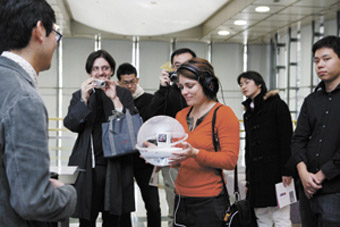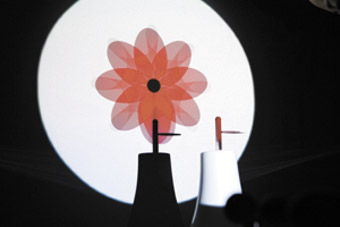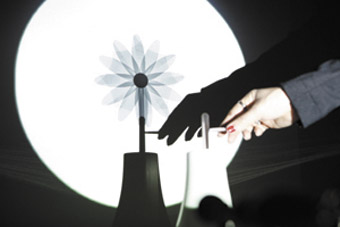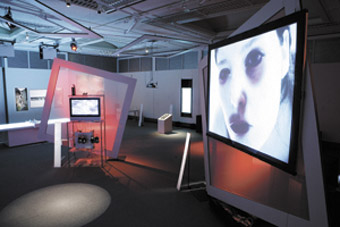the cool of artertainment
cat jones works through the japan media arts festival

Hide Andrew, Save Yourself!!!
IN SAVE YOURSELF!!!, ONE OF THE MORE INNOVATIVE WORKS IN THE 2006 JAPAN MEDIA ARTS FESTIVAL (STAGED IN EARLY 2007), THE PARTICIPANT HAS THEIR PHOTO TAKEN AND THEN FLOATED ON A FRAME INSIDE A FISHBOWL FULL OF WATER. THEY ARE HANDED THEMSELVES IN THE BOWL AND DON SPECIAL EARPHONES THAT TOUCH A SPOT ON THE NECK JUST UNDER THE EARS. THE WORK IS TURNED ON AND SUDDENLY, AFTER A PRICKLING IN THE EARS, THE PARTICIPANT FIGHTS WAVES OF SEASICKNESS AND LOSES ALL BALANCE WHILST TRYING DESPERATELY NOT TO SMASH THEIR FLOATING SELF ALL OVER THE FLOOR. THE VISCERAL AFFECTS LAST ALL DAY while the concept evaporates in a few minutes.
The Japan Media Arts Festival (JMAF) is competitive, international and centred on the exhibition of Award Winning Works held at the Tokyo Metropolitan Museum of Photography. The spatial design of the exhibition is based on origami, the concept that the unexpected can be made from a common sheet of paper. Entry plaques to the exhibition state that the aim of the festival is to promote the popularity of media arts and describe the growing cultural currency of Japanese media art, games, animation and manga as ‘Japan Cool.’ The festival is definitely achieving its aim of popularising media art with audiences growing from 2,000 to 68,000 in the 10 years since it began.
The exhibition comprises three floors of screened, documented and installed work grouped in the submission categories Art, Entertainment, Animation and Manga. The festival includes Symposia, the 12th Computer Graphics Contest for Students, the Leading Edge Technology Showcase and a Manga Library. The week-long screening program is made up of long and short animation and Manga sessions, documentaries on the festival’s award winners and compilations from international festivals—SIGGRAPH, Seoul International Computer Animation Festival (SICAF), Ars Electronica and Australia’s Electrofringe.

plaplax, hanahana
The selected works in the Art and Entertainment divisions are focused on technology, technique and aesthetic. Innovation in this year’s festival lies mainly in the perfecting of these elements rather than in conceptual content, perhaps because the festival is funded and partly run by the Japanese government’s Agency for Cultural Affairs, perhaps because entries are selected with no distinction between professional, amateur, independent or commercial production, and the Japanese term “media geijitsu” can be translated as art or entertainment. If Australia chose to develop the commercial growth of the media arts industry this way perhaps we could invent a new label. Australian Cool could be known as ‘artertainment’ or even ‘artattainment’ for the art consumers out there. It’s an odd idea for a director of Electrofringe, Australia’s Festival of Uncool, to take away.

plaplax, hanahana
The Jury for the eclectic Entertainment Division claimed they saw no innovation this year, only refined applications of known forms and the expansion of content—important in increasing public access to digital entertainment. There was a clear inclination to link traditional aesthetics with digital entertainment in Japanese works such as Shaberu! DS Oryouri, a voice activated cooking navigator, and PaperCraft Modelling Software. Novelty was certainly evident in Katsumoto Yuichiro’s invention, Amagatana, a plastic umbrella fitted with a set of earphones and an acceleration sensor that transports the playful brolly wielder to a solo sword fight (and a new wave of fad toys?). The trailer for this work features the artist travelling through city and country playing air sword. Aiming to be a winner, this young artist’s business card is printed on sandpaper and designed to, over time, scratch out the name on the card kept behind it.
Works in the Art Division, which includes the fluid categories of Installation, Interactive Art, Visual Image, Still Image and Web Works largely lacked emotional content, focusing instead on the mechanical actions of viewers and often with geometrically abstract visual manifestations. A trend appears to favour translating scientific phenomenon over commentary on human relations. The influence of artificial intelligence research is evident with many artists exploring notions of the individual and the group, the part and the whole.

Johanna Reich, front
The one work with emotional depth (albeit uncomfortable) was Johanna Reich’s front (Germany), a video of a young woman fighting an unseen opponent whilst bruises and wounds appear on her from the invisible strikes she receives. The festival chose not to install the sound aspect of front, a language duel that carries the work deeper than the image.
The use of technology by Japanese artists is noticeably rigorous—the best, the latest, the simplest and the most aesthetically pleasing—but many of the interactive forms are by nature rational, employing familiar domestic devices. In contrast, Jonathan den Breejen and Marenka Deenstra’s PingPongPixel ([Netherlands] represented by a video documentary) is completely irrational. It creates an image made of ping-pong balls from any digital image loaded by the viewer. Software analyses and converts the image into black and white pixels. The data of each pixel (colour and position) is represented by an individual ping-pong ball. The software then activates a ping-pong ball feeder (that looks like a huge backyard experiment made of tubes and buckets) and loads the balls into a perspex frame to create a large scale ping-pong pixel image. It appears to take a day for the ping pong balls to load and this grossly delayed satisfaction combined with the sloppy, clunky mechanics of the ball feeder, seems to make a comment about the ‘advance’ of technology. It’s bizarre and hilarious.
Without a strong media dramaturgy that rigorously connects content with forms of interaction and the behavioural psychology of the viewer, interactive art can easily be reduced to mere game play and novelty. Sosu Hockey by Takano Jiro is a prime (bad joke) example of this—a tabletop game in which the player aims to collect as many prime numbers as they can whilst repelling the rest. Why is it in the Art Division? Who can say?
The two works most innovative in form are hanahana by plaplax and Save Yourself!!! (see opening paragraph) by Hide Andrew. hanahana is an interactive scent project where animations of flowers and butterflies, bees, cats, dogs and noses are triggered by an aromatic sensor when viewers squirt aromas on paper leaves.
The beauty of some immersive interactive works is in allowing the viewer to create their own experience or even narrative. Tablescape Plus by Y Kakehi, T Naemura and M Matsushita does this, if nothing else. A white box with a tabletop screen is set with white pieces on which little projections evoke a park scene. There are people, trees, a bench and the sounds of birds, crickets, crows, and trees moving in the breeze. The pieces are movable and the images animate according to the direction, location and quality of movement. The park people turn their backs if moved away, and break into a trot if moved fast.
I create an average day at the park. When I accidentally bump the edges of two park people they bow and greet each other in a high pitched conversation that only stops when they separate. A balding man in an ill-fitting suit and sporting a large moustache bumps into a bench and is immediatly seated on it. I fetch a friend for him to chat with but she chooses to stand behind him. I coax her to sit. She eventually concedes as long as the distance of a scaled meter is maintained. Only silence here—no chatting—and only two at a time on the bench, please. Meanwhile I take a tall blond man as far as a copse where he frightens a flock of birds that erupt across the park. He loiters there for a minute to see if the moustached man will join him. He does, frightening another flock of birds. A lady approaches but turns away when it looks like the blond man is going to pee in the bushes. When I shift a piece quickly the characters get snappy and a heated exchange ensues. It takes a little while for them to settle down and apologise but eventually I leave them bowing eternally to each other.
Japan Media Arts Festival (JMAF), Feb 24-March 2007http://plaza.bunka.go.jp
RealTime issue #78 April-May 2007 pg. 12






